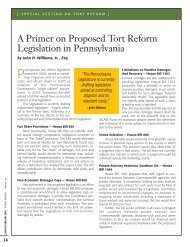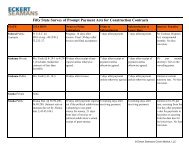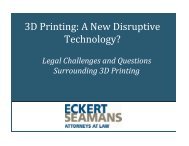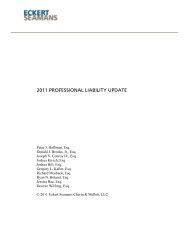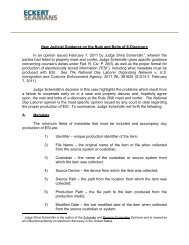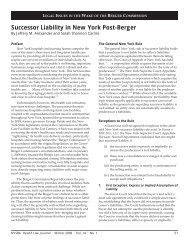whose death, in 2005, was allegedly caused in part by defendants’ failure, in 1998, toadminister a necessary dose of Rh immunoglobin. Id. at 378-80.This alleged negligence occurred in 1998, and was known to plaintiffs at that time,but plaintiffs did not file their lawsuit until 2007. Id. at 380. Defendants, relying on 42 Pa.C.S. § 5502(a), alleged that the applicable two-year statute of limitations for wrongful deathand survival actions began to run when the alleged negligent act had been done, in 1998.Id. at 382. Plaintiff countered, and the court agreed, that the specific language of 40 P.S. §1303.513(d) controlled over the general statutory language of 42 Pa. C.S. § 5524, andconsequently plaintiffs had properly commenced their wrongful death/survival actionwithin two years after the death of their child. Id. at 382. The Court also found that evenunder the more general statutory language to be found in the Judicial Code, Defendant’sstatute of limitations argument would not prevail. The Superior Court found that thesurvival claim did not begin to run until at the earliest, the child’s birth, and that as to thewrongful death claim, no pecuniary harm was present until the child’s death, and thesurvival claim brought on behalf of the child was not time-barred – meaning therefore thatneither was the wrongful death claim.(h)VenueSignificant changes have been enacted with respect to the propriety of venue in medicalmalpractice actions in Pennsylvania. First, the MCARE revised existing law regarding venue.Specifically, section 5101.1 of the Act relates to venue in medical malpractice actions. See 42P.S. § 5101.1. While previous venue principles essentially permitted an action to be filed in acounty in which any defendant conducted business or had sufficient contacts, Section 5101.1(b)specifically provides that a medical professional liability action may only be filed in the countyin which the cause of action arose. See id.The Pennsylvania Commonwealth Court has deemed 42 P.S. § 5101.1 unconstitutional.North-Central Pennsylvania Trial Lawyers Ass’n v. Weaver, 827 A.2d 550 (Pa. Commw. Ct.2003) (en banc). In North-Central, petitioners alleged that the provisions of Act 127, the act thatgave rise to Section 5101.1, violated Article V, Section 10(c) of the Pennsylvania Constitutionpertaining to the Supreme Court’s power to prescribe general procedural rules governingoperation of the courts. 827 A.2d at 558. The court held that Section 5101.1 was procedural innature because it affects the procedure by which the rights of an individual claiming an injurycaused by medical negligence may be effectuated but does not create, define, or regulatesubstantive rights. Id. Further, the court reasoned, in the absence of a countervailingconstitutional provision authorizing the legislature to act in regard to venue in a particular area,the matter of venue is committed to the exclusive authority of the Supreme Court pursuant toArticle V, Section 10(c). Id. at 559. Consequently, the court concluded that Act 127, to theextent that it purported to change the general rules about venue in medical professional liabilityactions, exceeded the authority of the legislature and was therefore unconstitutional. Id.The Superior Court, however, has declined to be bound by the Commonwealth Court’sholding in North-Central. Connor v. Crozer Keystone Health Sys., 832 A.2d 1112, 1116 n.3 (Pa.Super. 2003) (noting that the Superior Court is not bound by any decision of the CommonwealthCourt and declining to further address the constitutionality of 42 P.S. § 5101.1).102
Secondly, as noted above, the Pennsylvania Rules of Civil Procedure have recently beenrevised to conform to the General Assembly’s changes set forth in MCARE. Rule 1006, relatingto change of venue, provides that a medical malpractice action may be brought against a healthcare provider only in a county in which the cause of action arose. See Pa. R. Civ. P. 1006(a.1).Moreover, the revisions provide that if an action to enforce a joint or joint and several liabilityclaim against two or more defendants includes one or more medical malpractice claims, theaction must be brought in any county in which venue may properly be laid against any defendantunder subdivision (a.1). See Pa. R. Civ. P. 1006(c)(2). Further, Section (f)(2) of the rulestipulates that if one or more of the causes of action stated against the same defendant is amedical malpractice claim, the action must be brought in a county required by subdivision (a.1).See Pa. R. Civ. P. 1006(f)(2). The revisions to Rule 1006 as applied to individual defendants areincorporated into the following other Rules of Civil Procedure: 2130 (Partnerships as Parties);2156 (Unincorporated Associates as Parties); 2179 (Corporations and Similar Entities as Parties).See Pa. R. Civ. P. 2130, 2156, 2179. Significantly, the Commonwealth Court, in holding Section5101.1 unconstitutional, made no ruling concerning the constitutionality of the amended Pa. R.Civ. P. 1006. See North-Central Pennsylvania Trial Lawyer’s Ass’n v. Weaver, 827 A.2d 550(Pa. Commw. Ct. 2003) (en banc). See also Forrester v. Hanson, 901 A.2d 548, 552 n.3 (Pa.Super. 2006).By an Amendatory Order dated March 3, 2003, the Pennsylvania Supreme Court ruledthat Pa. R. Civ. P. 1006 “shall apply to medical professional liability actions filed on or afterJanuary 1, 2002 and not to such action filed prior to that date.”(i)RemittiturWhere a health care provider challenges a verdict on the basis of its excessiveness,MCARE establishes a standard for the court’s evaluation of the challenge. 40 P.S. § 1303.515.The trial court shall consider whether the health care provider’s satisfaction of the verdict willimpact the availability of the community’s access to medical care. 40 P.S. § 1303.515(b). If it isdetermined that the verdict results in a limitation of the community’s availability to healthcare,then the trial court may reduce award accordingly. Id. If the trial court has not adequatelyconsidered the impact of paying the verdict upon availability and access to health care in thecommunity in denying remittitur, an appellate court can find that the trial court abused itsdiscretion. 40 P.S. § 1303.515(c). Also, a trial court or appellate court may limit or reduce theamount of the security that the defendant health care provider must post to prevent execution ifthe court finds that requiring a bond in excess of the insurance policy limits would effectivelydeny defendant’s right to an appeal. 40 P.S. § 1303.515(d).(j)Ostensible AgencyMCARE modifies Pennsylvania’s doctrine of ostensible agency for causes of actionarising after the Act’s effective date. Under pre-MCARE case law, plaintiffs were required tosatisfy two factors before they could establish a cause of action against a healthcare institutionunder the ostensible agency theory, even where the alleged offending physician was not amember of the staff of the healthcare institution. First, plaintiffs must show that they looked tothe health care institution as opposed to the individual physician, and that the institution “heldout” the physician as its employee. Under MCARE, however, a healthcare provider can be held103
- Page 3 and 4:
EMTALA CASES ......................
- Page 5:
Filing an Affidavit of Non-Involvem
- Page 8 and 9:
II.PROFESSIONAL LIABILITY - AN OVER
- Page 10 and 11:
The Superior Court reversed the tri
- Page 12 and 13:
to a third party pursuant to the st
- Page 14 and 15:
After approximately five months, De
- Page 16 and 17:
learned the day after the surgery t
- Page 18 and 19:
conduct to the delay in colon cance
- Page 20 and 21:
court admitted the expert’s testi
- Page 22 and 23:
(b)(c)other reasonable causes, incl
- Page 24 and 25:
corroborated his testimony. The cou
- Page 26 and 27:
husband’s estate. Plaintiff alleg
- Page 28 and 29:
Other notable federal cases arising
- Page 30 and 31:
The Superior Court found that in re
- Page 32 and 33:
§ 1303.512(b). The court, however,
- Page 34 and 35:
In Neidig v. United States, No. 07-
- Page 36 and 37:
Additionally, the Supreme Court not
- Page 38 and 39:
were not indicated for her conditio
- Page 40 and 41:
surgeon is the same as it would be
- Page 42 and 43:
It should be noted that the Superio
- Page 44 and 45:
Finally, the court held that the tr
- Page 46 and 47:
The Supreme Court of Pennsylvania r
- Page 48 and 49:
nurses deviating from applicable st
- Page 50 and 51:
certainty, the court reviews expert
- Page 52 and 53:
Under Pennsylvania law, the Court n
- Page 54 and 55:
testimony, Defendant presented his
- Page 56 and 57:
Following Cooper v. Roberts, 286 A.
- Page 58 and 59: Plaintiff developed chronic diarrhe
- Page 60 and 61: where payment is made by Medicaid w
- Page 62 and 63: accomplished. In Valles v. Albert E
- Page 64 and 65: In 1980, the Pennsylvania Superior
- Page 66 and 67: Plaintiff had a routine monitoring
- Page 68 and 69: Plaintiff’s Contract ClaimsThe Co
- Page 70 and 71: is a failure to report changes in a
- Page 72 and 73: unit to assure post-surgical patien
- Page 74 and 75: sliced his wrist and arm with a raz
- Page 76 and 77: licensed professionals for whom the
- Page 78 and 79: (c)Limitations of Corporate Neglige
- Page 80 and 81: Even more recently, our Superior Co
- Page 82 and 83: (a)HMO IssuesIn McClellan v. Health
- Page 84 and 85: affidavit submitted by Defendants o
- Page 86 and 87: treatments while at VA’s faciliti
- Page 88 and 89: [s]ubstantively, we believe that a
- Page 90 and 91: The party claiming the benefit of t
- Page 92 and 93: deprive (him) of civil rights guara
- Page 94 and 95: found that the District Court was w
- Page 96 and 97: With respect to fraudulent concealm
- Page 98 and 99: would be applied in situations wher
- Page 100 and 101: they had not raised them in the cou
- Page 102 and 103: (a)Informed ConsentUnder MCARE, a p
- Page 104 and 105: civil enforcement provisions and ma
- Page 106 and 107: MCARE also changes the manner in wh
- Page 110 and 111: vicariously liable if the plaintiff
- Page 112 and 113: health center or its equivalent or
- Page 114 and 115: In Pennsylvania Medical Society, th
- Page 116 and 117: to any professional who is alleged
- Page 118 and 119: Since the 2005 amendments, there ha
- Page 120 and 121: ule, but who intentionally ignores
- Page 122 and 123: the original Complaint was delivere
- Page 124 and 125: foreclose all challenges against th
- Page 126 and 127: number of boxes), which was support
- Page 128 and 129: questions of professional judgment
- Page 130 and 131: deviated from any professional stan
- Page 132 and 133: The Third Circuit affirmed the Dist
- Page 134 and 135: claims and cross-claims remain agai
- Page 136 and 137: By an Amendatory Order dated March
- Page 138 and 139: The court acknowledged that there i
- Page 140 and 141: apply and that the trial court misa
- Page 142 and 143: Barbados had enough litigation-spec
- Page 144 and 145: E. Preemption of Vaccine Design Def
- Page 146 and 147: 2. Pa. R. Civ. Pro. 1036.1 - Reinst
- Page 148 and 149: Barrick, at *34-35.Furthermore, the
- Page 150 and 151: (b) the utility of the defendant’
- Page 152 and 153: 2006). In this case, Plaintiffs bro
- Page 154 and 155: B. Elements of a Cause of Action fo
- Page 156 and 157: decision in Muhammad precluded Mr.
- Page 158 and 159:
considered speculative “only if t
- Page 160 and 161:
underlying cause of action involved
- Page 162 and 163:
In Capital Care Corp., the Superior
- Page 164 and 165:
The court found, however, to state
- Page 166 and 167:
of reasonable diligence. The standa
- Page 168 and 169:
not be set aside. On July 7, 2005,
- Page 170 and 171:
complete bar to recovery. Since a l
- Page 172 and 173:
On appeal, Plaintiffs claimed that
- Page 174 and 175:
In Liggon-Redding, 659 F.3d at 265,
- Page 176 and 177:
elieved of those minimum standards
- Page 178 and 179:
elevant to the proceedings, the com
- Page 180 and 181:
establish professional misconduct b
- Page 182 and 183:
Upholding the Superior Court’s Or
- Page 184 and 185:
Id.Rejecting revocation and suspens
- Page 186 and 187:
order as a sanction under Rule 4019
- Page 188:
{1009912]182




